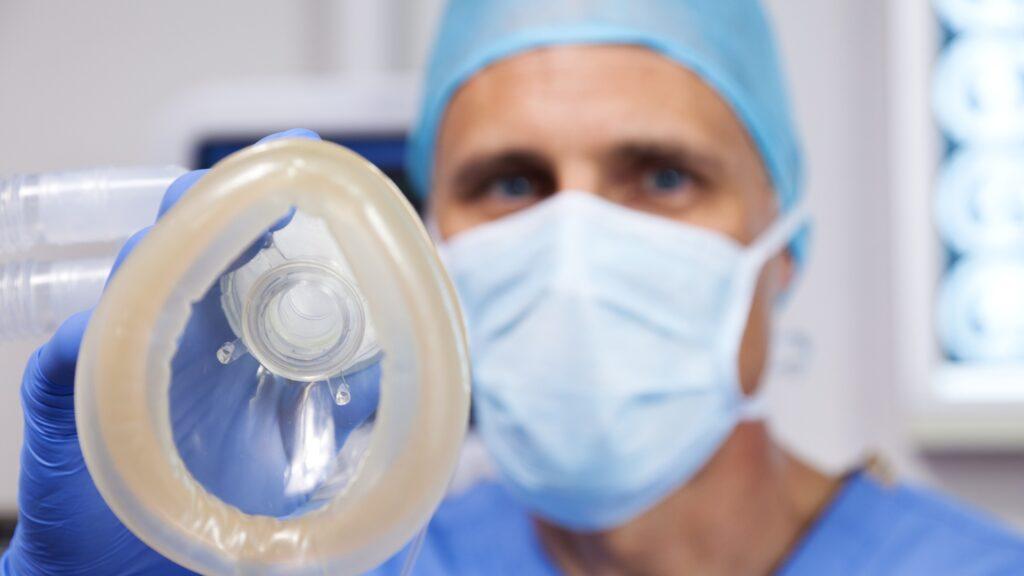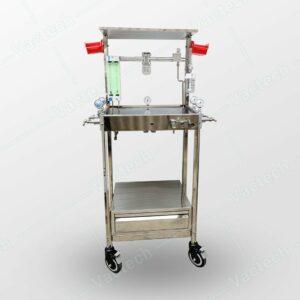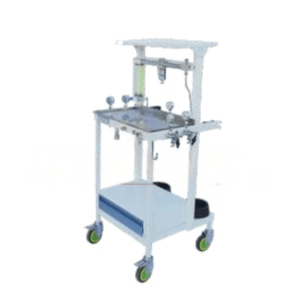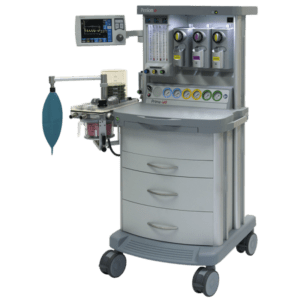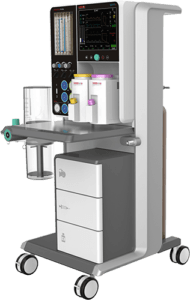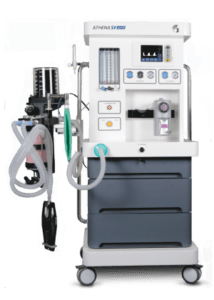Are you seeking in-depth knowledge about Anesthesia Machine and Workstation? Look no further! In this blog, we will delve into the diverse array of anesthesia machines employed in medical settings, their distinctive attributes, and the differentiation between anesthesia machine and workstations. We’ll delve into the advanced features and technologies incorporated in modern anesthesia machines, ensuring precise control and enhanced patient safety. Learn crucial steps and best practices for maintenance and servicing to ensure optimal performance and longevity of these vital medical devices.
To aid your decision-making process, we’ll provide insights into anesthesia machine costs, including initial investment, maintenance, and potential long-term savings. Furthermore, we’ll explore cutting-edge advancements in anesthesia technology.
At Medzell, a futuristic B2B platform for promoting Indian medical devices in emerging markets, we understand the importance of high-quality anesthesia equipment. Let’s embark on this informative journey together and unlock the world of anesthesia machines and workstations!
Introduction to Anesthesia Machine & Workstation
Anesthesia machines play a crucial role in the medical field. These sophisticated devices provide controlled delivery of gases and anesthetic agents to patients, allowing anesthesia providers to monitor and adjust the dosage as needed. Anesthesia machines have evolved over the years, incorporating advanced technologies and features to enhance patient safety and improve workflow efficiency. This introduction will delve into the fundamentals of anesthesia machines, exploring their components, functions, and the various types available in modern healthcare settings. Understanding the basics of anesthesia machines is essential for healthcare professionals involved in anesthesia administration and patient care.
Types of Anesthesia Machines
There are several types of anesthesia machines available, each designed to cater to specific medical settings and patient needs. Here are some common types:
- Standalone Anesthesia Machines: These are traditional, standalone devices that provide the necessary gases and anesthetic agents for anesthesia administration.
- Integrated Anesthesia Workstations: These machines combine anesthesia delivery with advanced monitoring and ventilation capabilities, streamlining the anesthesia process.
- MRI-Compatible Anesthesia Machines: Specifically designed for use in magnetic resonance imaging (MRI) environments, these machines ensure the safety of both patients and medical personnel.
- Portable Anesthesia Machines: Compact and lightweight, these machines are suitable for use in ambulatory or remote settings where mobility is essential.
- Veterinary Anesthesia Machines: Designed specifically for use in veterinary practices, these machines cater to the unique anesthesia requirements of animals.
Understanding the different types of anesthesia machines is crucial for healthcare providers to select the most suitable device for their specific clinical needs.
Features and Technologies of Modern Anesthesia Machines
Modern anesthesia machines are equipped with advanced features and technologies to ensure precise control, patient safety, and enhanced workflow efficiency. Here are some key features:
- Integrated Monitoring Systems: These machines often include integrated monitoring capabilities, such as ECG, pulse oximetry, capnography, and blood pressure monitoring, allowing real-time patient assessment.
- Touchscreen Displays and User-Friendly Interfaces: Anesthesia machines now come with intuitive touchscreen displays and user-friendly interfaces for easy navigation and control of various parameters.
- Automated Gas Delivery: Advanced machines offer automated gas delivery systems, ensuring accurate administration of anesthetic gases and agents based on patient requirements.
- Ventilation Modes: They provide a range of ventilation modes, including volume-controlled and pressure-controlled ventilation, to accommodate different patient needs.
- Safety Features: Modern anesthesia machines incorporate safety mechanisms such as low-pressure and oxygen concentration alarms, along with fail-safe systems to prevent adverse events.
- Data Integration and Connectivity: These machines may have connectivity options, enabling seamless integration with electronic medical records (EMR) systems and data sharing.
Essential Guide to Anesthesia Machine & Workstation Maintenance
Proper maintenance of anesthesia machines is crucial to ensure their optimal performance and patient safety. Here are some key maintenance practices:
- Regular Inspection: Conduct routine inspections to check for any signs of wear, damage, or malfunctioning components. Inspect the breathing system, gas delivery system, and electrical connections.
- Cleaning and Disinfection: Follow manufacturer guidelines for cleaning and disinfecting the machine, including surfaces, breathing circuits, and accessories. Use recommended cleaning agents and techniques to prevent contamination.
- Calibration and Testing: Regularly calibrate the anesthesia machine to ensure accurate readings of pressure, flow, and concentration. Perform functional testing to verify proper functioning of alarms, safety features, and ventilation modes.
- Preventive Maintenance: Adhere to a preventive maintenance schedule recommended by the manufacturer. This includes checking and replacing consumables, such as filters, hoses, and valves, as well as lubricating moving parts.
- Documentation and Record-Keeping: Maintain comprehensive records of maintenance activities, including inspections, cleaning, calibration, and repairs. This helps track the machine’s history and aids in identifying any recurring issues.
Advantages of Anesthesia Machine & Workstation
Here are some key benefits:
- Integrated Monitoring: Anesthesia workstations often include integrated monitoring systems that provide real-time data on vital signs, oxygen levels, and anesthesia agent concentrations. This allows for comprehensive patient monitoring during procedures.
- Streamlined Workflow: Workstations are designed to streamline the anesthesia delivery process with intuitive interfaces, easy-to-use controls, and organized workspaces. This helps improve efficiency and reduces the risk of errors.
- Ergonomic Design: Workstations are ergonomically designed to enhance operator comfort and reduce fatigue during long procedures. They feature adjustable heights, easy access to controls, and optimized positioning of monitors and equipment.
- Space Efficiency: Workstations are compact and occupy less space compared to separate anesthesia machine and monitor setups. This is particularly beneficial in crowded operating rooms or during transport.
- Enhanced Safety Features: Workstations often incorporate advanced safety features such as built-in alarms, pressure relief valves, and fail-safe mechanisms. These features help ensure patient safety and minimize the risk of complications.
Ensuring Anesthesia Machine Safety: Best Practices
Ensuring anesthesia machine safety is of paramount importance in medical settings. Adhering to best practices and protocols is crucial for safe operation and minimizing potential risks during anesthesia administration.
Key measures for anesthesia machine safety include thorough pre-use checks, regular equipment maintenance, and adherence to manufacturer guidelines. This involves inspecting gas and vapor delivery systems, monitoring alarms and indicators, and verifying proper functioning of safety features.
Furthermore, healthcare professionals should undergo comprehensive training on anesthesia machine operation and safety guidelines. This includes understanding emergency protocols and being familiar with the alarm systems and monitoring capabilities of the machine.
Implementing these best practices enables healthcare providers to establish a secure environment for anesthesia administration. And leading to optimal patient outcomes and mitigating the risk of adverse events.
Selecting the Right Anesthesia Machine & Workstation for Your Practice
Selecting the right anesthesia machine for your practice requires careful consideration of various factors. First, you need to assess your patient population and the types of procedures commonly performed to ensure the machine meets the specific requirements. Additionally, consider your budgetary constraints and find a balance between functionality and cost-effectiveness.
Exploring customization options is crucial to tailor the machine to your unique needs. Look for adjustable parameters, modular components, and compatibility with different anesthesia techniques. This flexibility allows for optimal customization based on your practice’s preferences and protocols.
By considering patient population, procedures, budget, and customization options, you can make an informed decision. And select an anesthesia machine that enhances patient safety, improves workflow efficiency, and meets the specific demands of your practice.
Exploring Cutting-Edge Advancements in Anesthesia Technology
The field of anesthesia technology is constantly evolving, incorporating cutting-edge advancements that revolutionize patient care. Automation plays a significant role, in streamlining anesthesia administration processes and reducing the risk of human error. By automating routine processes, healthcare professionals can focus more on patient care and safety.
Real-time monitoring is another critical advancement, allowing continuous assessment of a patient’s vital signs during anesthesia. This enables prompt detection of any changes or complications, leading to timely interventions and improved patient outcomes.
Enhanced ventilation modes have also transformed anesthesia administration. These modes provide precise control over the delivery of oxygen and anesthetic gases, optimizing respiratory support and ensuring the patient receives the appropriate levels of anesthesia.
By exploring these cutting-edge advancements in anesthesia technology, healthcare providers can enhance patient outcomes, improve efficiency in anesthesia administration, and ultimately deliver safer and more effective care.
Understanding Anesthesia Machine & Workstation Costs
When considering the implementation of anesthesia machines in medical practices, it is essential to understand the associated costs. An in-depth analysis of anesthesia machine costs involves evaluating multiple factors, including the initial investment, ongoing maintenance expenses, and potential long-term savings.
The initial investment includes the purchase price of the anesthesia machine and any additional accessories or features required for specific procedures. Maintenance costs encompass regular servicing, calibration, and replacement of parts to ensure optimal performance and compliance with safety standards.
To optimize costs and maintain sustainable anesthesia practices, healthcare providers can explore various strategies. These may include considering the total cost of ownership over the machine’s lifespan, exploring options for equipment financing or leasing, implementing preventive maintenance programs, and leveraging technology advancements for efficient resource utilization.
By understanding anesthesia machine costs and implementing effective cost optimization strategies, medical practices can achieve financial sustainability while delivering safe and high-quality anesthesia services to their patients.
Embracing the Future of Anesthesia Machine & Workstation
Embrace the future of anesthesia machines and unlock the full potential of innovative technology and patient-centric care. With the rapid advancements in anesthesia technology, including automation, real-time monitoring, and advanced ventilation modes, the landscape of anesthesia administration is undergoing a significant transformation.
Revolutionary cutting-edge technologies are transforming the delivery of anesthesia, leading to enhanced patient outcomes and improved efficiency in anesthesia procedures. By embracing these innovations and adopting patient-centric care approaches, healthcare providers can create a safer and more personalized anesthesia experience. From enhanced control and precision to improved patient monitoring and comfort, the future of anesthesia machines holds great promise for delivering optimal anesthesia care and shaping the future of the medical practice.
Anesthesia Machine & Workstation from Leading Indian Manufacturers
Major 22 S
Major 22 S is designed and developed by Vactech Surgical Equipment, a leading manufacturer of medical equipment. This anesthesia workstation features a fully stainless steel trolley with front wheels equipped with brakes for easy maneuverability. It includes a two-tube rotometer with three side visibility and a luminous rear plate, ensuring clear visibility even in dark operation theaters. The workstation incorporates gas-specific pin index yokes made of brass with colored pressure gauges.
Major 22 S also includes a Goldman hlothane vaporizer and provision for mounting a temperature-controlled vaporizer. With safety features like a non-return cum pressure relief valve and audio-visual oxygen failure warning device, Major 22 S prioritizes patient safety during anesthesia administration. Additionally, it offers convenient oxygen outlets, emergency oxygen flush, and the capability to attach two oxygen and one nitrous oxide cylinder.
DAM-002 Anaesthesia Major
DAM-002 Anaesthesia Major is one of the best Anesthesia Machines by Dynamic International, a leading manufacturer and global supplier of anesthesia machines and workstations in India. This machine meets international safety standards and is equipped with precisely calibrated long oxygen and nitrous oxide flow meter tubes. It ensures the delivery of oxygen downstream of other gases and includes a Halothane vaporizer.
The workstation features Yokes with oxygen and nitrous oxide color-coded regulators and gauges. It is equipped with a non-return cum pressure relief valve to minimize gas backflow and offers an emergency oxygen flush button and outlet at the table level. DAM-002 Anaesthesia Major provides efficient and reliable anesthesia delivery, complying with industry standards to ensure patient safety.
Penlon Prima 460
BPL Medical Technologies Private Limited, an anesthetic workstation manufacturer and global supplier in India, presents the Penlon Prima 460, a fully equipped anesthesia system suitable for operating rooms. This workstation features an optional electronic flow display and a standard flowmeter, offering precise control of gas flow. With six ventilation modes, it provides versatility for various patient needs. The workstation includes a new top shelf with a safe GCX mounting mechanism for patient monitoring equipment.
This product is designed with compatibility for Selectatec back bars and offers electrical outlets based on regional requirements. The Penlon Prima 460 incorporates an illuminated workspace with a pull-out writing surface, aluminum uprights for hanging accessories compatible with GCX, and spacious drawer units for storage. With integrated CO2 absorber, bellows unit, and ventilator interface, it ensures efficient anesthesia administration and is compatible with hospital information systems (HIS).
Asteros Royale Vent X
Medion Healthcare Pvt. Ltd. presents the Asteros Royale Vent X, a part of their dynamic series of Anaesthesia Delivery Workstations known for functionality, ergonomic design, and aesthetics. This anesthesia machine is fabricated completely of FRP fiber in a single mold, ensuring durability. It features anti-static castor wheels for smooth mobility within medical facilities.
The Asteros Royale Vent X is a multiple gas-based anesthesia machine that provides a facility for low-flow anesthesia procedures. It incorporates safety features such as an anti-hypoxia guard, nitrous oxide cut-off system, oxygen failure alarm system, low battery alarm, and pressure alarm, ensuring patient safety during anesthesia administration. The workstation also includes an advanced closed circuit breathing system, a sleek user interface, and a stainless steel writing tray with ample storage capacity.
Athena SV200
Skanray Technologies Ltd. presents the Athena SV200, a 3 gas 5 tube low-flow anesthesia workstation with advanced features. It includes dedicated additional N2O cutoff and independent auxiliary O2 output, offering enhanced control over gas administration. The workstation incorporates AHD with ratio control and features an internal 3-liter O2 reservoir for efficient oxygen delivery. With a 6.5″ wide display, the Athena SV200 provides clear visibility of vital parameters. It offers CMV-VC/PC and SP ventilation modes to suit different patient requirements.
Revolutionizing Indian Medical Devices: Medzell’s Path to Global Emergence
Discover Medzell, a visionary B2B platform designed to promote Indian medical devices in emerging markets. With its futuristic approach, Medzell revolutionizes the healthcare industry by connecting manufacturers, suppliers, and distributors, facilitating seamless transactions and collaborations. This innovative platform offers a wide range of Indian medical devices, including anesthesia machines and workstations, ensuring access to high-quality and advanced healthcare solutions. Medzell’s comprehensive marketplace empowers healthcare professionals to explore a diverse range of products, compare features and make informed purchasing decisions. By leveraging Medzell’s extensive network and advanced technological infrastructure, Indian medical device manufacturers can expand their reach and establish a global presence in emerging markets, fostering growth and innovation in the healthcare sector.
